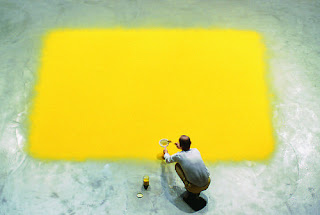I was sitting in the meeting room at the Fulton County Library in Johns Creek for the Fulton County Arts and Culture Public Art Seminar. As looking at powerpoint presentations by its staff, I suddenly felt as if I was in school again . . . it's painful for me to trace back my MFA schooling, yet I remembered a specific reading from one of my first theory classes regarding 'art institution' and what 'schooling' means . By constantly drawing yourself near people's inspiring presence, critical discussions, and new endeavours, you can indeed find yourself in a mode of self-schooling.
Before I go further, I would like to encourage you to apply for Fulton County Arts Registry. Go to http://www.fultonarts.org/forms-and-applications for application (they're in a process of updating the website). If you become a part of its registry, you automatically become a part of pool to be nominated for the Fulton County's public art opportunities. In upcoming years, they are expecting 15 projects with a budget of between $20,000 and $140,000 each. They also have a mentorship program to assist selected artists for public projects. Deadline March 11, 2011 and October 14, 2011.
 |
| untitled (body object series) #5-bushhead, 1984/1993, Ann Hamilton |
What matters most in art making for you? Did art school have anything to do with you coming to understand this?What matters most to me is paying attention. Art is the result of multiple acts of attention, and I hope that art making cultivates forms of listening. It seems to me that making allows one to create a situation to find what one needs to do in the world. It's a way to short-circuit your self-consciousness. I wait by keeping busy, by not worrying too much about whether a project is "good" or "successful." In school I was perhaps too concerned about this, but I slowly began to realize how making something is very different from thinking about it. If you sit around and wait for an interesting idea, you will wait for a very long time. I now believe that making is a form of thinking; experiences are a set of questions that propel me forward. They may be small questions, but they offer nourishment for the long term.
After flipping through a few pages of this book, I ran down to the basement and pulled out some of my early graduate school reading materials. I traced some of my favorite readings with underlines, highlights, and notes on... and was stunned to find how impactful those readings were in my developing body of work. I noted on words like 'stratum : a layer of material, naturally or artificially formed, often one of a number of parallel layers one upon another' and 'iteration : act of repeating.' These words were prophetic of my works to come. I also obsessively underlined and wrote notes on the article Wolfgang Laib: Transcendent Offerings. Here is a quote that is so clear in Wolfgang Laib's influence on my work:
The perishable and ephemeral materials Laib emplys indicate his comfort with impermanence; he cultivates the moment. The labor that goes into Laib's art is a form of meditation, its own reward; he is content to spend countless hours collecting pollen (it can take months to fill a few jars) and then shaping it into tiny cone-shaped hills for a piece . . . that a single sneeze could blow away. Requiring a form of labor that would be impossibly tedious to most of us, Laib's work with pollen, in particular, embodies an intrinsic awareness that it will exist only as long as its creator is available to make it happen.
Ah, love going back to these thoughts and notes!

Today, Atlanta Contemporary Art Center announced Louis Corrigan as a winner for Nexus Award 2011. Being able to work with someone like Louis Corrigan (a founder of Flux Projects and Possible Futures), I consider, is another schooling for me after school. Witnessing someone with a vision to generously and courageously support the art community has been eye-opening and uplifting. I am now challenged to think about patronage, artistic vision, and communal relationships as an artist. To read more about the award and Louis Corrigan, go to http://www.burnaway.org/2011/02/corrigan-wins-nexus-award/.
Cheers,
G.



No comments:
Post a Comment